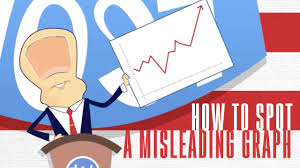How to spot a misleading graph

Have you seen those ads where graphs have been used as a means to attract your attention towards an agenda? Turns out, these graphs are often toyed with to mislead the desired audience.
Let’s look into how we’re easily swayed by these morphed representations.
Contents
What kind of tactics are used to change a graph’s overview?
By changing the scale of the graph, we can completely turn around the visual displayed in front of us. In order to spot the difference, you need to pay attention to the axes of the graph. Zooming in on a small portion on either of the axes can change the entire graph.
We equate the height of the bars with their values. So, changing the scale of the y-axis can deplete the difference between certain values in terms of their visual representation. Numerically, their values will stay intact. However, when we look at a graph, we generally measure the values in terms of how they’re presented to us instead of actually looking into the real numbers.
Another tactic employed is via manipulating the x-axis. The x-axis usually corresponds to the value of time, representing the rate of change of something.
What is Cherry-picking?
Sometimes the graph inaccuracies are brought forth by including unequal consecutive values. For better understanding, let’s consider three points of time- A, B and C. To achieve an attractive graph representation, one can manipulate the differences between these points. So, let’s say the gap between A and B happens to be 6 years. The representation will be changed if the reading of C exceeds the previous gap of 6 years. These differences are brought in to eliminate undesirable factors that might hamper the graph’s visual representation.
Therefore, cherry-picking is basically about choosing a time range carefully in such a manner that it excludes a major event affecting the representation. This is followed by picking specific date points to hide these significant deviations and present them with uniformity.
By doing so, the curators aren’t necessarily handing out wrong information, they are simply omitting certain points of reference.
Graphs make it easier for us to accept data and information. Nevertheless, these omissions are disguised so seamlessly into the visual that it gets hard to point them out with a single look. You need to look out for the labels and what the graph is attempting to chart out. Don’t just simply get manipulated by the rising curves or towering bars on the graph because it’s highly likely that they’re trying to mislead you.






Responses